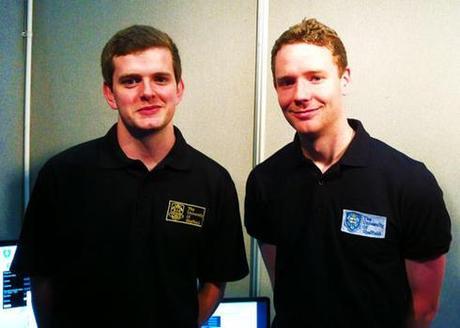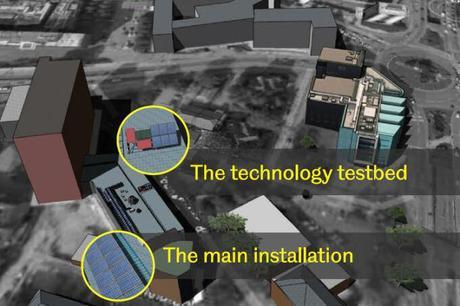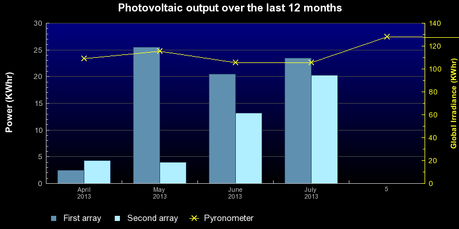
THE UNIVERSITY of Sheffield’s Project Sunshine is a collaboration between researchers from the university’s Engineering, Science and Social Science faculties to find solar solutions to world problems such as hunger, fossil fuel dependence, and behavior change.
Within Project Sunshine are specific projects that focus, for example, on algae’s potential as biofuel, or the protection of crops from pathogenic fungi (killer mushrooms).
One such project is the Sheffield Solar Farm, which tests different kinds of solar technology and methods of deployment on a 58m2 plot on a rooftop of one of the university buildings. The project publishes the result of its solar panel trials as a constant data journal on its Solar Farm website. Here you can see performance graphs, showing yield and efficiency, and compare them to other PV panels installed on the same rooftop.
The other major function of the website is to allow the public to submit their own data. Anyone with a PV array can submit their location and data on yield, generation and export, which is helpful for a number of reasons. For one, it helps Project Sunshine with its research. Secondly, it is valuable as a free resource for anyone who might be interested in solar, who can enter their own postcode and see how much energy and Feed in Tariff money has been generated by similar solar installations in their area.
Q&A with Sheffield Solar Farm
I met David Woodward and Jamie Taylor (they're the ones in the title picture) from the Sheffield Solar Farm team, and asked them some questions about the Solar Farm, and about the app they developed for it recently. Here are their answers.
What year are you in, and what degree are you going for?
Dave and I have both recently completed an MPhys degree (Masters in Physics). Dave is due to commence a PhD in particle physics in September and I’ll be working full time with the Sheffield Solar/ Microgen team at the University of Sheffield.
What do you picture yourself doing professionally?
I’d very much like to forge a career in software development and/or data analysis whilst Dave would like to continue on into research after his PhD.
 Above: Map of the Sheffield Solar Farm.
Above: Map of the Sheffield Solar Farm.
How have you become part of the Sheffield solar programme?
We were recruited part-time to the Sheffield Solar/ Microgen team in summer 2012 between the third and fourth years of our degrees. The team were looking for some students to help with the day-to-day running of the Microgen database and we were offered the opportunity by our project supervisor Alastair Buckley, who heads the Sheffield Solar project. During the same summer the remainder of our time was spent developing the iPad app aimed at educating people on the benefits of energy storage in PV systems.
What’s the aim of Sheffield Solar’s programme?
The Sheffield Solar Farm forms part of Project Sunshine, which aims to harness the power of the sun to tackle the increasing food and energy needs of the world’s population in light of uncertain climate and global environment change.
Funded by the Higher Education Innovation Fund, we aim to promote knowledge transfer and new links between industry, society and academia. The Solar Farm allows for real world testing of PV technologies whilst the Microgen-Database gathers generation data from PV installations across the UK and promotes further uptake of PV in the UK. The data collected in both cases will be distributed to researchers, installers, policy makers and the public.
How many people submit their data each month, and how many to date?
The Microgen-Database currently collects regular generation data from approximately 6000 installations, a number we hope will increase dramatically in the coming months thanks to our recent efforts in marketing such as attending eco exhibitions.
 Above: Example of a performance graph on the Solar Farm website.
Above: Example of a performance graph on the Solar Farm website.
So anyone can just enter their data – longitude, latitude etc – and discover how much energy their roof is likely to yield?
The generation predictor tool is designed to offer anyone who is interested in solar PV the opportunity to accurately estimate the generation they could expect to achieve based on parameters such as location, azimuth and elevation. We’ve built our own predictor based on data from the Microgen-Database but also offer users predictions based on SAP 2009, SAP 2012 and the PVGIS predictor tool, as well as displaying real generation data for the nearest PV installations in the M-D.
How accurate is your solar predictor?
We’re yet to analyze and quantify the accuracy of the predictor but it will depend on the density of PV installations we have in the database at a particular location.
And what kind of advice can people get, who already have PV?
All of our members or anyone interested in solar PV are welcome to contact us by email or phone for independent advice on pv performance issues, though our advice tends to be non-technology-specific. We also have an active forum on the Microgen website where users can seek advice and assistance from fellow PV users.
Above: Another performance graph
Tell us about the iPad app you both made – what does it do, how long did you take to build it, and where can people find it?
The purpose of the app is to demonstrate the potential role of energy storage for domestic PV installations. Using your location, some details about a solar installation and some information about your energy usage the app will calculate the amount of energy you can expect to generate from PV, the amount of that energy you will use in your home and how much will be exported back to the national grid. You can then see how these figures change if there was some way of storing this energy, for example in a battery.
It took a few months to research the relevant physics and write the algorithms which do the background calculations. We then worked with a developer to design and build the first version of the app, which is free to download at the Apple store.
How does Sheffield Solar work with industry?
We work with PV installers by collecting data from their installations to expand our Microgen-Database. In return we provide a free analysis service with monthly reports on system performance. We also provide a source of data for regulators and policy makers and work with industrial partners to develop PV performance reporting systems.
Thank you David and Jamie for the interview. For more information, visit the University of Sheffield's Project Sunshine, or the dedicated Sheffield Solar Farm website.
